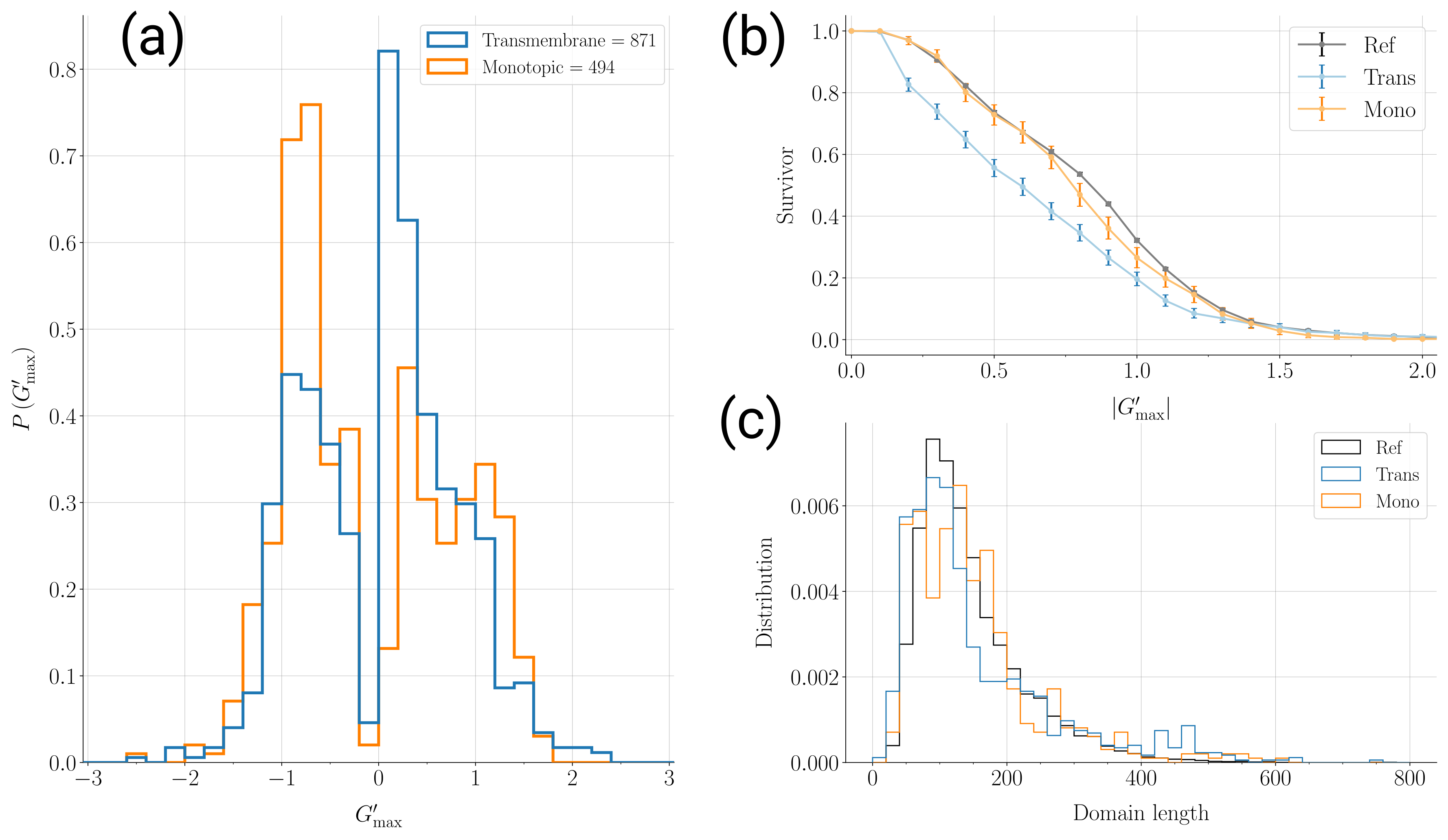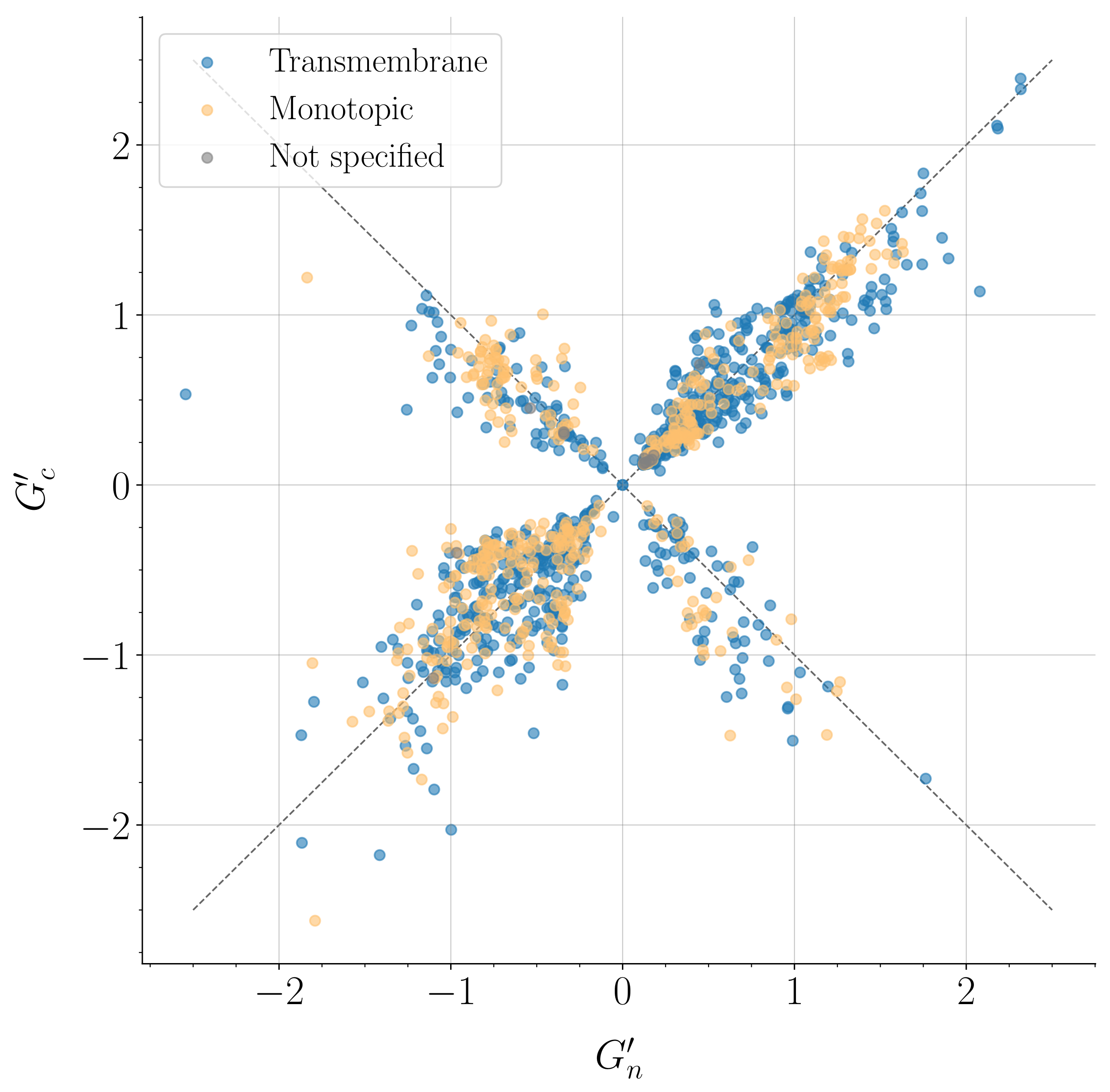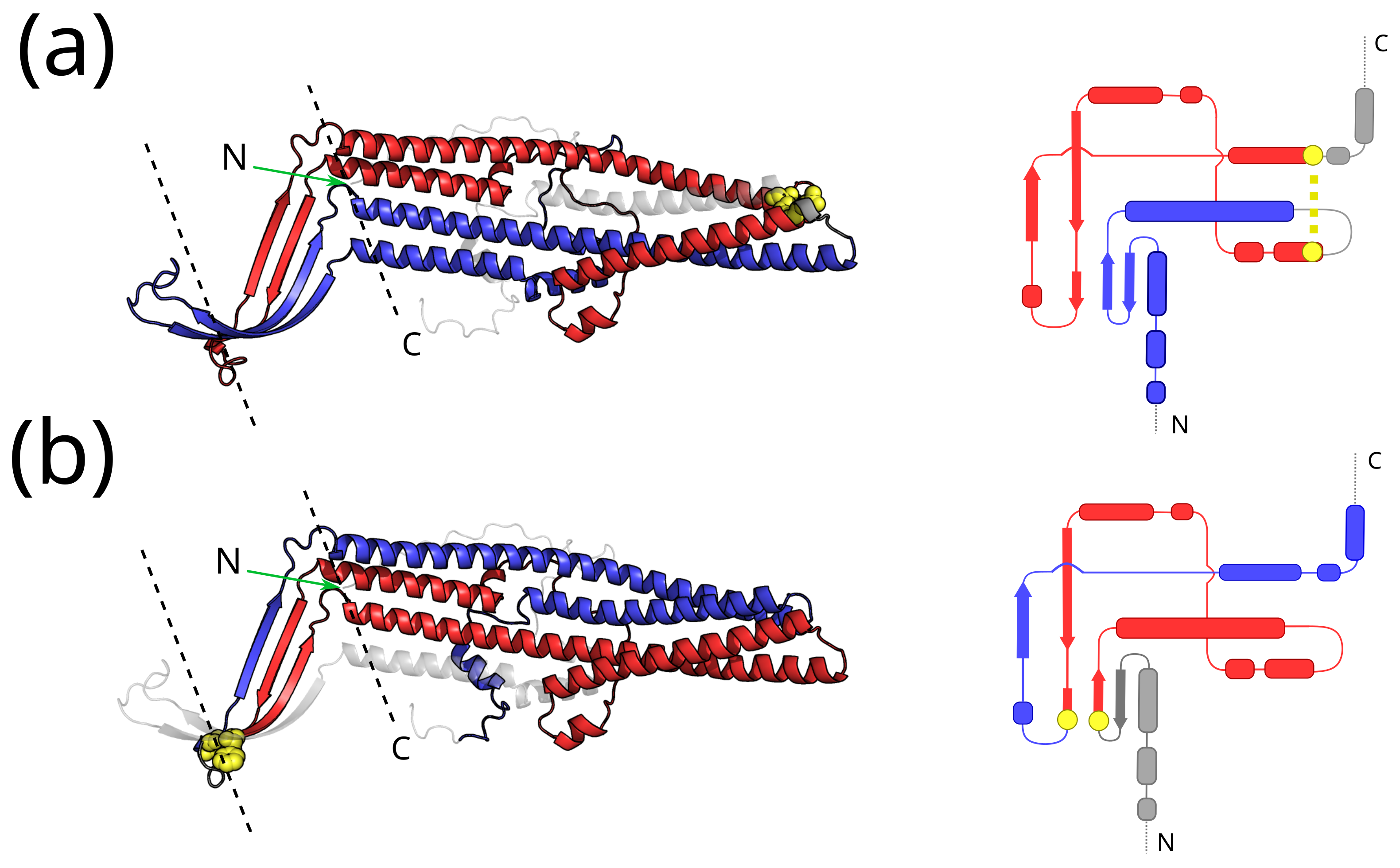Entangled Motifs in Membrane Protein Structures
Abstract
1. Introduction
2. Results
2.1. Pipeline for Computational Analysis
2.2. Membrane Proteins Contain a Significant Fraction of Entangled Motifs
2.3. A Specific Chirality bias for Double Winding Entangled Motifs Characterizes Membrane Proteins
2.4. Membrane Proteins Can Self-Entangle in a Variety of Ways
3. Discussion
4. Materials and Methods
4.1. Membrane Protein Dataset
4.2. Gaussian Entanglement and Modeling
Supplementary Materials
Author Contributions
Funding
Institutional Review Board Statement
Informed Consent Statement
Data Availability Statement
Acknowledgments
Conflicts of Interest
References
- Jelokhani-Niaraki, M. Membrane Proteins: Structure, Function and Motion. Int. J. Mol. Sci. 2023, 24, 468. [Google Scholar] [CrossRef] [PubMed]
- Von Heijne, G. The membrane protein universe: What’s out there and why bother? J. Intern. Med. 2007, 261, 543–557. [Google Scholar] [CrossRef] [PubMed]
- Finkelstein, J. Structures of membrane proteins. Nature 2014, 511, 21. [Google Scholar] [CrossRef]
- Dean, N. X-ray free electron lasers. Nature 2014, 511, 21. [Google Scholar] [CrossRef]
- White, S.H. Biophysical dissection of membrane proteins. Nature 2009, 459, 344–346. [Google Scholar] [CrossRef]
- Berman, H.; Henrick, K.; Nakamura, H. Announcing the worldwide Protein Data Bank. Nat. Struct. Mol. Biol. 2003, 10, 980. [Google Scholar] [CrossRef]
- Baker, D. A Surprising Simplicity to Protein Folding. Nature 2000, 405, 39–42. [Google Scholar] [CrossRef]
- Dokholyan, N.; Li, L.; Ding, F.; Shakhnovich, E. Topological determinants of protein folding. Proc. Nat. Acad. Sci. USA 2002, 99, 8637–8641. [Google Scholar] [CrossRef]
- Dill, K.A.; MacCallum, J.L. The Protein-Folding Problem, 50 Years On. Science 2012, 338, 1042–1046. [Google Scholar] [CrossRef]
- Micheletti, C.; Banavar, J.R.; Maritan, A.; Seno, F. Protein structures and optimal folding from a geometrical variational principle. Phys. Rev. Lett. 1999, 82, 3372. [Google Scholar] [CrossRef]
- Munoz, V.; Eaton, W.A. A Simple Model for Calculating the Kinetics of Protein Folding from Three-Dimensional Structures. Proc. Natl. Acad. Sci. USA 1999, 96, 11311–11316. [Google Scholar] [CrossRef]
- Alm, E.; Baker, D. Prediction of Protein-Folding Mechanisms from Free-Energy Landscapes Derived from Native Structures. Proc. Natl. Acad. Sci. USA 1999, 96, 11305–11310. [Google Scholar] [CrossRef]
- Clementi, C.; Nymeyer, H.; Onuchic, J.N. Topological and Energetic Factors: What Determines the Structural Details of the Transition State Ensemble and “En-Route” Intermediates for Protein Folding? An Investigation for Small Globular Proteins. J. Mol. Biol. 2000, 298, 937–953. [Google Scholar] [CrossRef]
- Hills, R., Jr.; Brooks, C., III. Insights from coarse-grained go models for protein folding and dynamics. Int. J. Mol. Sci. 2009, 10, 889–905. [Google Scholar] [CrossRef]
- Orlandini, E.; Seno, F.; Banavar, J.; Laio, A.; Maritan, A. Deciphering the folding kinetics of transmembrane helical proteins. Proc. Natl. Acad. Sci. USA 2000, 97, 14229–14234. [Google Scholar] [CrossRef]
- Schafer, N.; Truong, H.; Otzen, D.; Lindorff-Larsen, K.; Wolynes, P. Topological constraints and modular structure in the folding and functional motions of GlpG, an intramembrane protease. Proc. Natl. Acad. Sci. USA 2016, 113, 2098–2103. [Google Scholar] [CrossRef]
- Desikan, R.; Behera, A.; Maiti, P.; Ayappa, K. Using multiscale molecular dynamics simulations to obtain insights into pore forming toxin mechanisms. Methods Enzymol. 2021, 649, 461–502. [Google Scholar]
- Taylor, W.R. A deeply knotted protein structure and how it might fold. Nature 2000, 406, 916. [Google Scholar] [CrossRef] [PubMed]
- Jackson, S.E.; Suma, A.; Micheletti, C. How to Fold Intricately: Using Theory and Experiments to Unravel the Properties of Knotted Proteins. Curr. Opin. Struct. Biol. 2017, 42, 6–14. [Google Scholar] [CrossRef] [PubMed]
- Dabrowski-Tumanski, P.; Sulkowska, J.I. To Tie or Not to Tie? That Is the Question. Polymers 2017, 9, 454. [Google Scholar] [CrossRef]
- Virnau, P.; Mirny, L.A.; Kardar, M. Intricate knots in proteins: Function and evolution. PLoS Comp. Biol. 2006, 2, e122. [Google Scholar] [CrossRef]
- Lua, R.C.; Grosberg, A.Y. Statistics of knots, geometry of conformations, and evolution of proteins. PLoS Comp. Biol. 2006, 2, e45. [Google Scholar] [CrossRef]
- Bölinger, D.; Sulkowska, J.I.; Hsu, H.P.; Mirny, L.A.; Kardar, M.; Onuchic, J.N.; Virnau, P. A Stevedore’s protein knot. PLoS Comp. Biol. 2010, 6, e1000731. [Google Scholar] [CrossRef] [PubMed]
- Rawdon, E.; Millett, K.; Stasiak, A. Subknots in ideal knots, random knots, and knotted proteins. Sci. Rep. 2015, 5, 8928. [Google Scholar] [CrossRef]
- Jarmolinska, A.I.; Perlinska, A.P.; Runkel, R.; Trefz, B.; Ginn, H.M.; Virnau, P.; Sulkowska, J.I. Proteins’ Knotty Problems. J. Mol. Biol. 2019, 431, 244–257. [Google Scholar] [CrossRef]
- Zayats, V.; Perlinska, A.; Jarmolinska, A.; Jastrzebski, B.; Dunin-Horkawicz, S.; Sulkowska, J. Slipknotted and unknotted monovalent cation-proton antiporters evolved from a common ancestor. PLoS Comput. Biol. 2021, 17, 1009502. [Google Scholar] [CrossRef]
- Goundaroulis, D.; Dorier, J.; Benedetti, F.; Stasiak, A. Studies of global and local entanglements of individual protein chains using the concept of knotoids. Sci. Rep. 2017, 7, 6309. [Google Scholar] [CrossRef]
- Sulkowska, J.; Rawdon, E.; Millett, K.; Onuchic, J.; Stasiak, A. Conservation of complex knotting and slipknotting patterns in proteins. Proc. Natl. Acad. Sci. USA 2012, 109, E1715–E1723. [Google Scholar] [CrossRef]
- Frechet, D.; Guitton, J.; Herman, F.; Faucher, D.; Helynck, G.; Monegier du Sorbier, B.; Ridoux, J.; James-Surcouf, E.; Vuilhorgne, M. Solution structure of RP 71955, a new 21 amino acid tricyclic peptide active against HIV-1 virus. Biochemistry 1994, 33, 42–50. [Google Scholar] [CrossRef]
- Niemyska, W.; Dabrowski-Tumanski, P.; Kadlof, M.; Haglund, E.; Sułkowski, P.; Sulkowska, J.I. Complex lasso: New entangled motifs in proteins. Sci. Rep. 2016, 6, 36895. [Google Scholar] [CrossRef]
- Khatib, F.; Rohl, C.A.; Karplus, K. Pokefind: A novel topological filter for use with protein structure prediction. Bioinformatics 2009, 25, i281–i288. [Google Scholar] [CrossRef]
- Baiesi, M.; Orlandini, E.; Trovato, A.; Seno, F. Linking in Domain-Swapped Protein Dimers. Sci. Rep. 2016, 6, 33872. [Google Scholar] [CrossRef]
- Baiesi, M.; Orlandini, E.; Seno, F.; Trovato, A. Exploring the Correlation between the Folding Rates of Proteins and the Entanglement of Their Native States. J. Phys. Math. Theor. 2017, 50, 504001. [Google Scholar] [CrossRef]
- Zhao, Y.; Cieplak, M. Stability of structurally entangled protein dimers. Proteins 2018, 86, 945–955. [Google Scholar] [CrossRef] [PubMed]
- Baiesi, M.; Orlandini, E.; Seno, F.; Trovato, A. Sequence and Structural Patterns Detected in Entangled Proteins Reveal the Importance of Co-Translational Folding. Sci. Rep. 2019, 9, 8426. [Google Scholar] [CrossRef]
- Ricca, R.L.; Nipoti, B. Gauss’ Linking Number Revisited. J. Knot Theory Its Ramifications 2011, 20, 1325–1343. [Google Scholar] [CrossRef]
- Rogen, P.; Fain, B. Automatic classification of protein structure by using Gauss integrals. Proc. Natl. Acad. Sci. USA 2003, 100, 119–124. [Google Scholar] [CrossRef]
- Panagiotou, E.; Millett, K.C.; Lambropoulou, S. The linking number and the writhe of uniform random walks and polygons in confined spaces. J. Phys. A. Math. Theor. 2010, 43, 045208. [Google Scholar] [CrossRef]
- Panagiotou, E.; Kroger, M.; Millett, K.C. Writhe and mutual entanglement combine to give the entanglement length. Phys. Rev. E 2013, 88, 062604. [Google Scholar] [CrossRef]
- Vu, Q.V.; Sitarik, I.; Jiang, Y.; Yadav, D.; Sharma, P.; Fried, S.D.; Li, M.S.; O’Brien, E.P. A Newly Identified Class of Protein Misfolding in All-atom Folding Simulations Consistent with Limited Proteoly sis Mass Spectrometry. bioRxiv 2022. bioRxiv: 2022.07.19.500586. [Google Scholar]
- Salicari, L.; Baiesi, M.; Orlandini, E.; Trovato, A. Folding Kinetics of an Entangled Protein. bioRxiv 2022. bioRxiv: 10.1101/2023.04.17.537117. [Google Scholar]
- Norbiato, F.; Seno, F.; Trovato, A.; Baiesi, M. Folding rate optimization promotes frustrated interactions in entangled protein structures. Int. J. Mol. Sci. 2020, 21, 213. [Google Scholar] [CrossRef] [PubMed]
- Waudby, C.; Dobson, C.; Christodoulou, J. Nature and Regulation of Protein Folding on the Ribosome. Trends Biochem. Sci. 2019, 44, 914–926. [Google Scholar] [CrossRef]
- Zhu, M.; Kuechler, E.R.; Wong, R.W.; Calabrese, G.; Sitarik, I.M.; Rana, V.; Stoynov, N.; O’Brien, E.P.; Gsponer, J.; Mayor, T. Pulse Labeling Reveals the Tail End of Protein Folding by Proteome Profiling. Cell Rep. 2022, 40, 111096. [Google Scholar] [CrossRef]
- Nissley, D.A.; Jiang, Y.; Trovato, F.; Sitarik, I.; Narayan, K.B.; To, P.; Xia, Y.; Fried, S.D.; O’Brien, E.P. Universal Protein Misfolding Intermediates Can Bypass the Proteostasis Network and Remain Soluble and Less Functional. Nat. Commun. 2022, 13, 3081. [Google Scholar] [CrossRef]
- Jiang, Y.; Neti, S.; Sitarik, I.; Pradhan, P.; To, P.; Xia, Y.; Fried, S.; Booker, S.; O’Brien, E. How synonymous mutations alter enzyme structure and function over long timescales. Nat. Chem. 2023, 15, 308–318. [Google Scholar] [CrossRef]
- Sillitoe, I.; Bordin, N.; Dawson, N.; Waman, V.P.; Ashford, P.; Scholes, H.M.; Pang, C.S.M.; Woodridge, L.; Rauer, C.; Sen, N.; et al. CATH: Increased structural coverage of functional space. Nucleic Acids Res. 2020, 49, D266–D273. [Google Scholar] [CrossRef]
- Newport, T.D.; Sansom, M.S.; Stansfeld, P.J. The MemProtMD database: A resource for membrane-embedded protein structures and their lipid interactions. Nucleic Acids Res. 2018, 47, D390–D397. [Google Scholar] [CrossRef]
- Lomize, M.A.; Lomize, A.L.; Pogozheva, I.D.; Mosberg, H.I. OPM: Orientations of Proteins in Membranes database. Bioinformatics 2006, 22, 623–625. [Google Scholar] [CrossRef]
- Lomize, M.A.; Pogozheva, I.D.; Joo, H.; Mosberg, H.I.; Lomize, A.L. OPM database and PPM web server: Resources for positioning of proteins in membranes. Nucleic Acids Res. 2011, 40, D370–D376. [Google Scholar] [CrossRef]
- Tusnády, G.E.; Dosztányi, Z.; Simon, I. transmembrane proteins in the Protein Data Bank: Identification and classification. Bioinformatics 2004, 20, 2964–2972. [Google Scholar] [CrossRef] [PubMed]
- Kozma, D.; Simon, I.; Tusnády, G.E. PDBTM: Protein Data Bank of transmembrane proteins after 8 years. Nucleic Acids Res. 2012, 41, D524–D529. [Google Scholar] [CrossRef] [PubMed]
- Berman, H.M.; Westbrook, J.; Feng, Z.; Gilliland, G.; Bhat, T.N.; Weissig, H.; Shindyalov, I.N.; Bourne, P.E. The Protein Data Bank. Nucleic Acids Res. 2000, 28, 235–242. [Google Scholar] [CrossRef]
- Šali, A.; Blundell, T.L. Comparative Protein Modelling by Satisfaction of Spatial Restraints. J. Mol. Biol. 1993, 234, 779–815. [Google Scholar] [CrossRef]
- Webb, B.; Sali, A. Comparative Protein Structure Modeling Using MODELLER. Curr. Protoc. Bioinform. 2016, 54, 5.6.1–5.6.37. [Google Scholar] [CrossRef]
- Morgan, J.; McNamara, J.; Zimmer, J. Mechanism of activation of bacterial cellulose synthase by cyclic di-GMP. Nat. Struct. Mol. Biol. 2014, 21, 489–496. [Google Scholar] [CrossRef]
- Shaffer, P.; Goehring, A.; Shankaranarayanan, A.; Gouaux, E. Structure and mechanism of a Na+-independent amino acid transporter. Science 2009, 325, 1010–1014. [Google Scholar] [CrossRef]
- Su, C.C.; Radhakrishnan, A.; Kumar, N.; Long, F.; Bolla, J.; Lei, H.T.; Delmar, J.; Do, S.; Chou, T.H.; Rajashankar, K.; et al. Crystal structure of the Campylobacter jejuni CmeC outer membrane channel. Protein Sci. 2014, 23, 954–961. [Google Scholar] [CrossRef]
- Hegde, R.; Keenan, R. The mechanisms of integral membrane protein biogenesis. Nat. Rev. Mol. Cell Biol. 2022, 23, 107–124. [Google Scholar] [CrossRef]
- Sorokina, I.; Mushegian, A.; Koonin, E. Is Protein Folding a Thermodynamically Unfavorable, Active, Energy-Dependent Process? Int. J. Mol. Sci. 2022, 23, 521. [Google Scholar] [CrossRef]
- McGilvray, P.; Anghel, S.; Sundaram, A.; Zhong, F.; Trnka, M.; Fuller, J.; Hu, H.; Burlingame, A.; Keenan, R. An ER translocon for multi-pass membrane protein biogenesis. eLife 2020, 9, e56889. [Google Scholar] [CrossRef] [PubMed]






| Domains | Transmembrane | Monotopic | Unclassified |
| 1378 | 871 | 494 | 13 |
| Domains | Integral | Peripheral | Unclassified |
| 1378 | 871 | 490 | 17 |
Disclaimer/Publisher’s Note: The statements, opinions and data contained in all publications are solely those of the individual author(s) and contributor(s) and not of MDPI and/or the editor(s). MDPI and/or the editor(s) disclaim responsibility for any injury to people or property resulting from any ideas, methods, instructions or products referred to in the content. |
© 2023 by the authors. Licensee MDPI, Basel, Switzerland. This article is an open access article distributed under the terms and conditions of the Creative Commons Attribution (CC BY) license (https://creativecommons.org/licenses/by/4.0/).
Share and Cite
Salicari, L.; Trovato, A. Entangled Motifs in Membrane Protein Structures. Int. J. Mol. Sci. 2023, 24, 9193. https://doi.org/10.3390/ijms24119193
Salicari L, Trovato A. Entangled Motifs in Membrane Protein Structures. International Journal of Molecular Sciences. 2023; 24(11):9193. https://doi.org/10.3390/ijms24119193
Chicago/Turabian StyleSalicari, Leonardo, and Antonio Trovato. 2023. "Entangled Motifs in Membrane Protein Structures" International Journal of Molecular Sciences 24, no. 11: 9193. https://doi.org/10.3390/ijms24119193
APA StyleSalicari, L., & Trovato, A. (2023). Entangled Motifs in Membrane Protein Structures. International Journal of Molecular Sciences, 24(11), 9193. https://doi.org/10.3390/ijms24119193






